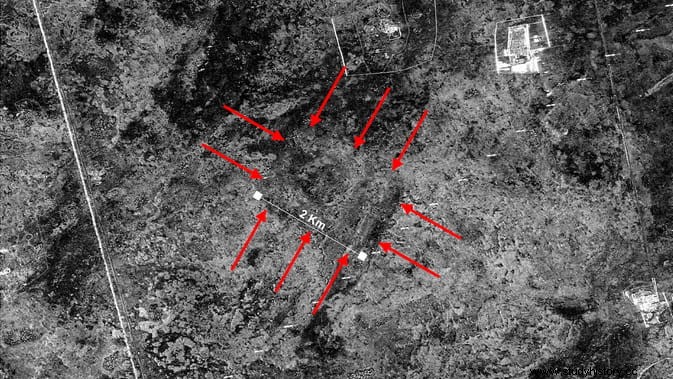Researchers searching for groundwater sources in the Eastern Arabian Peninsula for a project funded by the United States Agency for International Relief and Development have accidentally discovered the outlines of a settlement that appears to be more than 3,600 years old.
A symmetrical, 2 x 3 kilometer garden area or settlement outlines (and one of the largest potential settlements discovered in the area) were identified using advanced radar satellite imagery in an area of Qatar hitherto he believed there was little evidence of sedentary ancient civilizations.
The study, published in the ISPRS Journal of Photogrammetry and Remote Sensing , refutes the idea that this peninsula was totally nomadic and the evidence mapped from space indicates that the population seems to have had a sophisticated knowledge of the use of groundwater. The research also points to the critical need to study water and protect against climate fluctuations in drylands.

Makhfia , the name given to the settlement by researchers at the University of Southern California's Viterbi School of Engineering and the Jet Propulsion Laboratory by NASA (and referring to an invisible place in the local Arabic language), was discovered using L-band synthetic aperture radar images from the Japanese satellite ALOS 1 and specially acquired high-resolution radar images from its successor, ALOS 2.
Although the settlement was not visible from space with normal satellite imaging tools or through observation of the earth's surface, it was determined that the large underground rectangular parcel had to be man-made due to its shape, texture and composition of the soil, which contrasted sharply with the surrounding geological features. Independent carbon dating of recovered charcoal samples suggests that the site is at least 3,650 years old, which could date back to the same time as the Dilmun civilization. Lead author Essam Heggy of the USC Climate and Water Research Center describes the site as a natural fortress surrounded by very rugged terrain , which almost makes the area inaccessible.
This discovery has important historical and scientific implications. From a historical point of view, it may be the first proof of a sedentary community in the area, and perhaps an advanced engineering for the time. Although we cannot see the remains of a monument or the walls of a settlement, the proof is in the ground. The soil properties of the deposit have a different texture and surface composition than the surrounding terrain, a disparity typically associated with planting and landscaping.

A settlement of this size in this particular area, which is far from the coast where most ancient civilizations were found, is unusual, says Heggy. With this area now averaging 43 degrees Celsius in the summer months, this is like finding evidence of a very green ranch in the middle of Death Valley, California, dating back thousands of years . In addition, the site provides new data on the little-known climatic fluctuations that occurred in the region, and on how these changes could have affected human settlements and mobility.
Most importantly, researchers believe that this settlement must have been inhabited for a long period of time due to the development of agriculture and reliance on groundwater, a fact that speaks to the civilization's advanced engineering prowess. , given Qatar's complex aquifers and harsh terrain.
The researchers believe that a population knowledgeable enough to tap into such unpredictable groundwater resources - inaccessible by digging through hard limestone and dolomite - would certainly have been ahead of their time in mitigating droughts in the harsh environments of the world. inside. There is strong evidence that the inhabitants of this settlement resorted to deep groundwater extraction, a method by which water from deeper aquifers is accessed through fractures in the ground, in order to use this water for irrigation. of crops and to maintain daily life.
The presence of this settlement now allows researchers to reconstruct the most recent paleoclimatic changes that took place in the eastern Arabian Peninsula. The dark side of this, Heggy says, is that we don't quite know who this culture was and why it disappeared. However, based on the presence of charcoal found at the site, Heggy and his colleagues suggest that fire could be one of several plausible explanations for its disappearance. This evidence calls for further study of this area by archaeologists, says Heggy.

The work also has some implications for how we study and deal with climate fluctuations today. Deserts cover about 10% of our planet. Today we might think that they were always habitable, but this discovery (along with others in the area) shows that this might not always have been the case says Heggy, who is a research scientist in the USC Ming Hsieh Department of Electrical Engineering. His concern is that increased climatic fluctuations in drylands may exacerbate food insecurity, migration and degradation of water resources.
Why should people care about the ruins of this ancient settlement? For Heggy, this culture's ability to mitigate climate fluctuations could be our story. This story is very important today. In drylands, we have widespread disbelief in climate research. Many think that climate change is something in the future or far in the 'geological' past. This deposit shows that it has always been here and that our recent ancestors have made its mitigation a key to their survival , he affirms.
Heggy remains hopeful. He asserts that NASA's upcoming desert-focused Earth observation missions will bring new subsurface mapping capabilities and provide unique insights into the paleoclimatic evolution of deserts, as well as human presence in desert areas over time. weather fluctuations.
Fonts
University of Southern California | Essam Heggy, Jonathan Normand, Elizabeth M. Palmer, Abotalib Z. Abotalib , Exploring the nature of buried linear features in the Qatar peninsula:Archaeological and paleoclimatic implications , ISPRS Journal of Photogrammetry and Remote Sensing, Volume 183, 2022, Pages 210-227, ISSN 0924-2716, doi.org/10.1016/j.isprsjprs.2021.10.007
